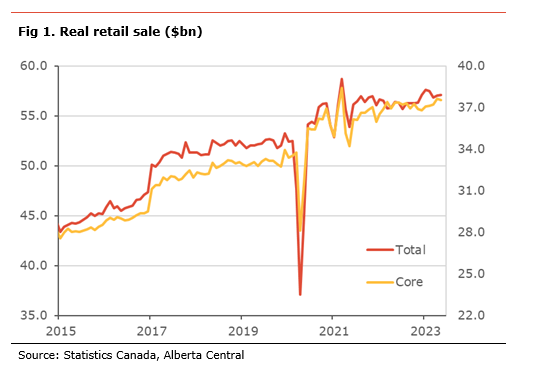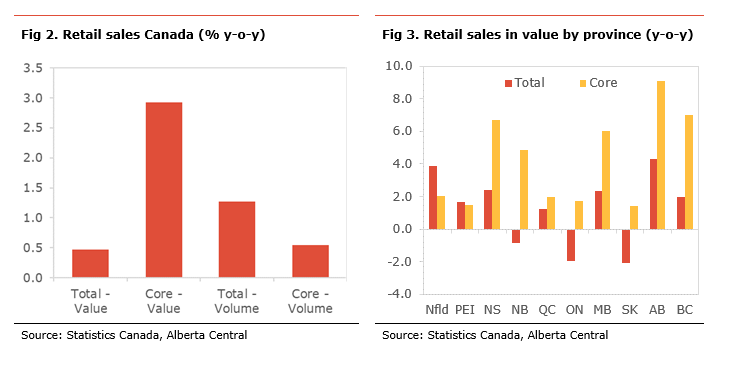Economic insight provided by Alberta Central Chief Economist Charles St-Arnaud.
Bottom line: Retail sales increased modestly in May and the preliminary estimate suggests that sales remained unchanged. After some strength in late 2022 and earlier this year, there are clear signs that consumer spending is stalling. The moderation in consumption is even more evident when adjusting for inflation and population growth.
There are some significant regional divergences. At one end, consumer spending adjusted for inflation in Alberta remain strong, even once adjusted for population growth, while it is contracting in Ontario and Saskatchewan in volume.
The outlook for retail sales and consumer spending more broadly remains tilted to the downside. Consumers’ finances continue to be squeezed by an erosion in purchasing power due to high inflation and rising interest rates (see The Great Consumer Squeeze for more details on how those factors affect households). The resilience in the labour market, with continued robust job growth, is likely a significant support to household spending. An underperformance in job growth, especially job losses, could lead to significant underperformance in consumer spending.
Retail sales rose 0.2% m-o-m in May. Compared to the same month last year, retail sales rose +0.5% y-o-y. Statistics Canada also reports that retail sales are estimated to have been unchanged in June based on a preliminary estimate.
Monthly sales increased in 5 out of 9 subsectors. The biggest rises on the month were in food and beverage (+1.0% m-o-m), motor vehicles and parts (+0.8% m-o-m), and sporting goods, hobby, books and other (+0.8% m-o-m). These increases were partly offset by lower spending at building material and garden centres (-1.5% m-o-m), clothing and footwear (-0.8% m-o-m), and general merchandise retailers (-0.7% m-o-m).
Core retail sales, which excludes motor vehicles and parts and gasoline stations, were flat on the month (+2.9% y-o-y). The focus on core retail sales is important in the current context, as lower gasoline prices is leading to a sharp decline in sales at gasoline station (-22.6% y-o-y)
In volume terms (i.e. adjusted for inflation), retail sales rose by 0.1% in May (+1.3% y-o-y) and core retail sales are estimated to have eased by 0.3% on the month (+0.5% y-o-y).
By provinces, there are some important divergences. Focusing on the y-o-y changes, retail sales increase the most in Alberta (+4.3% y-o-y), Newfoundland (+3.9% m-o-m), Nova Scotia (+2.4% y-o-y), and Manitoba (+2.3% y-o-y). On the flip side, retail sales are lower in Saskatchewan (-2.1% m-o-m), Ontario (-1.9% y-o-y), and New Brunswick (-0.8% y-o-y).
Looking at core retail sales, they increase the most in Alberta (+9.1% y-o-y), British Columbia (+7.0% y-o-y), Nova Scotia (+6.7% m-o-m), and Manitoba (+6.0% y-o-y). Spending increased the least in Saskatchewan (+1.4% y-o-y), PEI (+1.5% m-o-m), Ontario (+1.7% y-o-y), and Quebec (+2.0% y-o-y).
In Alberta, retail sales declined slightly in November (+6.0% y-o-y). Retail sales were mixed across sectors. Big increase at motor vehicle and parts dealers (+3.4% m-o-m), gasoline stations (+1.8% m-o-m), Health and personal care stores (+11.9% m-o-m), and clothing and footwear stores (+11.9% m-o-m) were partly offset by declines at building and gardening centres (-9.1% m-o-m), food stores (-1.8% m-o-m), and furniture, electronic and appliance stores (-1.3% m-o-m).
Core retail sales declined by 2.0% m-o-m (+6.2% y-o-y) in November. Although there are no official volume details at the provincial level, we estimate that retail sales volumes in the province decreased by 0.4% m-o-m (+0.7% y-o-y).
Statistics Canada has recently started to release retail sales numbers for Calgary and Edmonton. The data shows some divergences between regions. As such, retail sales in Calgary rose by 10.3% y-o-y while it increased a more modest 5.5% y-o-y in Edmonton and 5.4% in the rest of the province. The core measure also shows the same trend with Calgary up 13.1% y-o-y compared to 7.0% and 7.3% for Edmonton and the rest of the province, respectively. Stronger population growth in Calgary over the past year than in Edmonton and the rest of the province could explain part of the outperformance.




Independent Opinion
The views and opinions expressed in this publication are solely and independently those of the author and do not necessarily reflect the views and opinions of any organization or person in any way affiliated with the author including, without limitation, any current or past employers of the author. While reasonable effort was taken to ensure the information and analysis in this publication is accurate, it has been prepared solely for general informational purposes. There are no warranties or representations being provided with respect to the accuracy and completeness of the content in this publication. Nothing in this publication should be construed as providing professional advice on the matters discussed. The author does not assume any liability arising from any form of reliance on this publication.